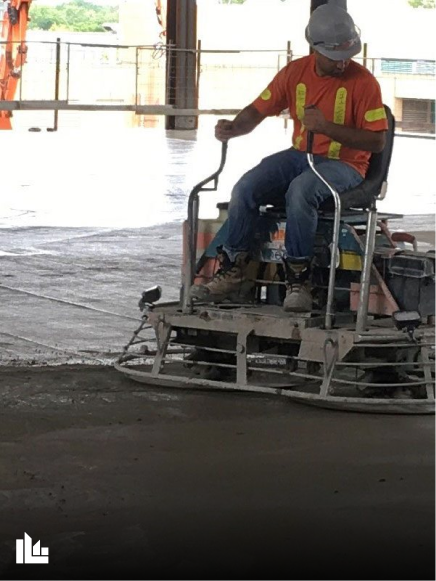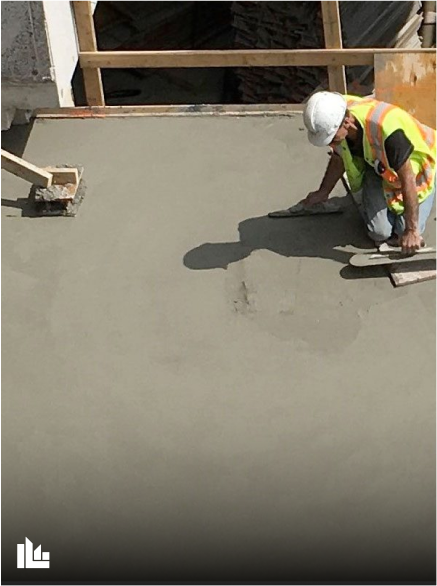
Floor Finishing
The main three aspects of floor finishing are maintaining the wear and tear of the surface, protecting controlled environments from seepage of water, and creating an even and comfortable surface for the users. Limen provides these aspects by placing, finishing and saw cutting services for the concrete slabs in residential, commercial, institutional, and industrial projects. Highly skilled teams, wide ability in selecting and operating proper equipment followed by professional QA/QC measures including advanced laser guided equipment allow us to appropriately place and finish concrete slabs within requested tolerances.
Our teams include experienced and professional estimators, project managers, foremen and certified floor finishers equipped with required tools and skills which allow them certainly handle projects from simple slab on grade at driveways to advance super flat floors in warehouses.
With regards to the preparation and implementation of the project, our focus is always on the results. Having this target in mind, we examine and utilize the most feasible approach to deliver the product with the highest level of quality which is specified for the project.
Our strategy in providing the best customer service is supported by years of developing and growing our team in a professional environment. We always consider two aspects of quality and risk management in mind prior to and throughout the implementation of each project. With regards to the quality, we make sure that the work is well planned, and all equipment and skilled tradesmen are assigned to the project as required. If a mockup is expected to ensure the quality will not be compromised, we will provide written and detailed procedures and checklists in advance. Upon receipt of approval, we will proceed with placing the mockup for observation and inspection prior to performing the actual work. In risk management, we always consider the safety of our team and others who may get affected by our execution as the highest risk consideration in our risk register and will plan and take all necessary steps to avoid negative safety impacts.
Floor Finishing
We offer the following types of floor finishing services:
- Basic Finish: This type of floor finish is a smooth surface created using screeds and trowels. Immediately after concrete has been placed in forms, floor finishers utilize a screed to level out the concrete surface. This type of finish is ideal for some suspended slabs and slab on grade applications with unbounded finishes.
- Troweling or Floating: This type of finish can be accomplished through manual or mechanical means. A manual trowel is simply a flat steel blade with an attached handle that is pushed and pulled across the concrete surface. On the other hand, power trowels are typically used on large commercial and industrial projects where using hand trowels is not feasible. Regardless of the means, trowel finish is the most common and popular finish of concrete used in all types of concrete slab applications.
- Edging: this method is performed to create rounded or beveled edges on the edges of the finished floor as well as to create joints where needed in the surface to help minimize cracking. A specific edging tool is used to accomplish this task.
- Broom Finish: concrete surfaces without a broom finish tends to be slippery and dangerous when liquids are present on the surface. To make concrete surfaces slip resistant, a broom finish can be employed. This method is done after placement, leveling, and troweling of concrete. When a smooth surface has been formed, a rough textured finished with ridges for traction control can be obtained by dragging a broom across the surface of the concrete, specifically when the concrete surface is wet.
- Polished Concrete: To achieve a clean and glossy look of concrete surface especially in museums, auditorium, and galleries with an easy to maintain application, polished concrete is one of the top items on the list. The polishing process is usually achieved by using concrete floor grinders that are equipped with diamond abrasives. The grade of the abrasives, from coarse to fine, will define the final smoothness of the concrete surface when the polishing process is completed. Partially through the polishing process, chemical hardeners are regularly added to the concrete to provide future protection against water infiltration. Finer abrasives are used until the desired surface finish is achieved. The final step includes application of a sealing product to protect the concrete from chemicals, staining and moisture, if necessary.

Concrete Texture
Besides broom finish texture, there are multiple ways to apply texture to concrete surfaces:
- Exposed Aggregate Finish: an exposed finish is created by washing the top layer of concrete away, which exposes the surface of the basic aggregates that are mixed into the concrete or specific iron free additives such as rose quartz, limestone, dark gray or black basalt, red or blue granite and even colored glass or seashells. This provides an attractive and slip resistant finish but it’s important to provide a high-quality seal after concrete curing to protect the surface.
- Salt Finish: this type of finish is mainly used for swimming pool decks and other wet areas. Salt finishes are formed by applying rock salt or inserting coarse rock salt crystals using rollers to the top of the wet concrete and then washing it away, which leaves small pits in the finished surface. This finish gives a decorative, rocky delicate texture and slip resistance to plain or colored concrete.
Stamped Concrete: concrete stamps are consisting of panels with engraved designs applied to concrete while it is still curing. Designs may consist of brick, stone, or other decorative patterns to provide the anticipated look, sometimes mocking other building materials, but preserving the strength and durability of concrete. Stamped concrete finish is an intelligent approach in concrete texturing and is widely applied for floor in patios, driveways, and sidewalks.
Concrete Coloring
If your project requires specific look that fits with the architectural or interior design requirements, concrete coloring which can be accomplished through mix-added pigments or post-cure staining, which both methods can provide pleasing looks to the concrete surface and match it with the surrounding environment if desired.
- Pigments: this method is a simple process, achieved by adding the pigments directly to the concrete mix prior to pouring. Pigments are available in liquid form or in ready-mix dissolvable bags. The range of colors diverges from earthy variants of browns and tans to greens, blues, and grays. It is important to keep pigmented concrete well sealed throughout its lifetime to prevent water infiltration, which may cause the pigment to fade.
- Concrete Stain: the color of concrete can also be controlled by using a variety of staining products. One common method of staining concrete is using acid. Stains can be applied to concrete of any age, though the colors are normally more vibrant if the stain is applied comparatively after the concrete has been placed. Concrete stain application is typically followed by installation of appropriate sealant over the concrete to protect the surface.

Featured Projects
From contracting to complicated design-build and P3 projects, Limen brings the right solutions at the right time, with the right people, to turn your vision a reality.
The Company We Keep



